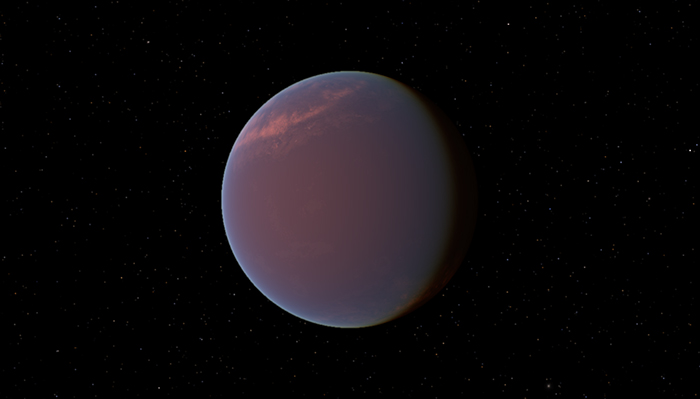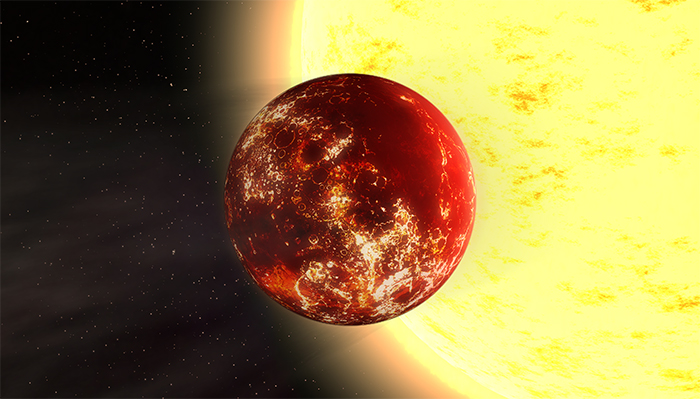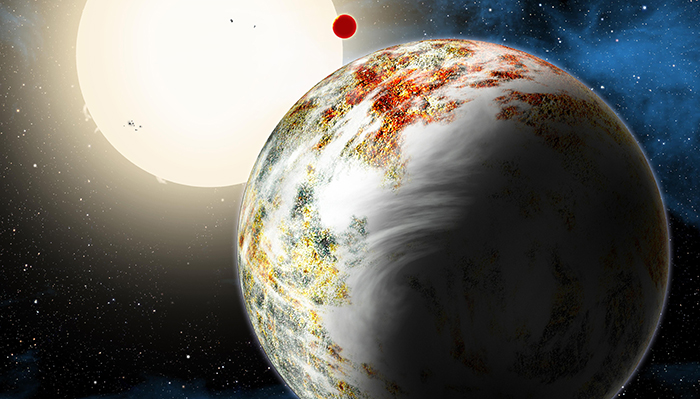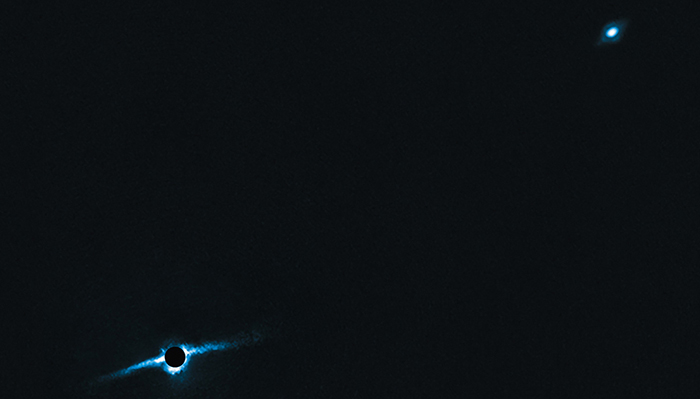We all know that space is weird as it is. Its mysteriousness is precisely why people have been fascinated with the night sky and space exploration since the beginning of life on Earth. There are things there that are beyond our comprehension and that defy the traditional laws of physics. Hence, no matter how hard we try to understand and explain our vast universe, there will always be mysteries yet to be unraveled.
Internet user Anthony Hackett has compiled a list of the most mysterious and weird exoplanets—planets outside our solar system. Other internet users have also jumped in and extended the list with possibly habitable planets. Before diving into this article about unique planets, let’s understand more about exoplanets.
What Is an Exoplanet?
All the planets in our solar system orbit around the Sun, but the celestial bodies that orbit around other stars are called exoplanets. Exoplanets are challenging to detect because they are hidden by the bright glare of the stars they orbit. That’s why astronomers use indirect methods to find them.
They might measure the dimming of a star that happens to have a planet pass in front of it or monitor the star’s spectrum to see if another planet is pulling on it and causing its light to “Doppler shift.”
Scroll down to learn more about these unknown planets. It’s time to learn fascinating exoplanet and space facts and for some low-key space travel.
This post may include affiliate links.
J1407b - An Exomoon Or A “Saturn On Steroids”
J1407b has been referred to as a “Saturn on steroids” or “Super Saturn” due to its massive system of circumplanetary rings, which is about 640 times that of Saturn’s rings. It is an exoplanet located 434 light years from Earth in the constellation of Centaurus and is the only known exoplanet with rings similar to Saturn.
If this planet swapped places with Saturn, its rings would dominate the Earth’s sky and appear many times larger than a full moon. There is a large gap halfway through the ring system, and a Mars-sized exomoon may orbit the planet within this gap. If aliens live on this exomoon, they have an extraordinary view looking up into the sky.
Gliese 581c - A Potentially Habitable Exoplanet
Gliese 581c is an exoplanet located 20 light years or 120 trillion miles (192 trillion kilometers) from Earth in the constellation of Libra. The planet orbits its star at a distance of 6.8 million miles (around 10.9 million kilometers), only 7% of the 93 million miles (150 million kilometers) between the Earth and the Sun.
Gliese 581c is tidally locked, meaning that one side of the planet always faces the star, and the other never does. The closer side experiences scorching temperatures that would instantly melt you alive, while the farther side experiences freezing temperatures that could instantly turn you into a snowman. Between these two extremes, however, is a narrow strip of land with better conditions that could theoretically support alien life. In 2008, we sent a radio message to Gliese 581c, which is expected to reach the planet in 2029.
To think in billions of years, some of these planets could be habitable, and we wouldn't live to see it. Really makes you feel small, huh?
Gj 1214b - The Waterworld
It is the most likely candidate for being an ocean planet. GJ 1214b has no land—only oceans stretching over its surface. If it is a water world, it could be considered a bigger and hotter version of Jupiter’s Galilean moon Europa.
Gliese 436b - A Planet Defying The Laws Of Physics
Gliese 436b is an exoplanet located 30 light years from Earth in the constellation of Leo and seems to defy the laws of Physics. One orbit around the star takes only about two days or 15.5 hours. This planet orbits its star at a distance 15 times closer than Mercury is to the Sun. Its icy surface is roasting at 439°C (822°F). So how does ice, of all things, remain completely solid at 439 degrees above its melting point?
Because the gravity on this rare planet is so powerful, it compresses the trace amounts of water vapor in the planet’s atmosphere into solid ice and prevents it from melting, no matter how much it burns.
55 Cancri E - A Diamond Planet
55 Cancri E is only about 40 light-years away from us in the Cancer constellation. It is twice the size of Earth but is nearly eight times larger and twice as dense. It is so close to its parent star that it takes a mere 18 hours for the planet to complete a full orbit.
The parent star has much more carbon than the Sun, and the planet’s mass is considered largely carbon. Due to the pressure and average maximum surface temperature of 2400°C (4417°F), this “super-Earth” is believed to be covered with diamonds.
Hat-P-7b - Where It Rains Rubies And Sapphires
HAT-P-7b is located in the Cygnus constellation, about 1000 light-years from Earth. On the night side of this strange planet, high precipitation of aluminum oxide (corundum) is found in the atmosphere.
Because corundum gems are rubies and sapphires, one can describe the hypothetical weather on the planet’s night side as “raining rubies and sapphires.” The planet also faces violent storms, so it’s likely that these rubies and sapphires are scattered planet-wide.
Psr J1719-1483 B - Orbits Around A Pulsar
This planet orbits a pulsar—an extremely compact and dense neutron star about the size of a large city. This one has a diameter of 12 miles (19 kilometers), but its mass is 1.4 times the mass of the Sun. Another thing about pulsars is that they rotate quickly. Therefore, this planet has an orbital period of 2 hours.
Hd 189733b - Where It Rains Glass
HD 189773b is slightly larger than Jupiter in our solar system and is about 62 light years away from Earth. This cool-looking planet gets its deep, beautiful azure color from its strange atmosphere, which is made up mostly of silicate atoms and particles. The planet’s wind speeds can reach as high as 5,400 miles per hour, around 2 kilometers per second (seven times faster than the speed of sound). Temperatures can also reach over 900°C (1652°F) on the planet.
What is horrid and frightening about this planet is that it literally rains glass sideways, along with unbearably fast winds. If this storm were somehow to occur at Earth’s equator, it would travel around the Earth in just five and a half hours.
Note to self, do not under any circumstances visit HD 189773b for any reason ever,
Wasp-12b - A Planet That’s Eating Up Light
WASP-12b is one of the darkest known exoplanets. The planet’s day side eats light rather than reflecting it into space. This weird planet, which is twice the size of Jupiter, has the unique ability to trap at least 94% of the visible starlight falling into its atmosphere. The day side hoards all the visible light because it always faces its star. The temperature of its atmosphere is a soaring 4,600°C (8,312°F). This oddball exoplanet is one of a class of so-called “hot Jupiters” that orbit very close to their host star and are heated to enormous temperatures.
The planet orbits so close to its host that it has fixed day and night sides. WASP-12b completes an orbit once a day. The night side is much cooler, with temperatures roughly 2,200°C (3,992°F), which allows water vapor and clouds to form. A swirl of material from the planet’s super-heated atmosphere spills onto its star.
Gj-504b - The Pink Planet
This beautiful pink, or should we say magenta-colored exoplanet, is the resident of the Virgo constellation. Its name is Gliese 504 b (often referred to as GJ-504b), and it orbits its star from nearly nine times the distance that Jupiter orbits the sun. One interesting characteristic of this planet is that it’s a newly formed planet that is still glowing with heat, making the surface appear magenta.
Kepler-10c - A Mega-Earth
Kepler-10c lies 560 light-years from Earth in the constellation Draco, where it orbits Kepler-10 with a year of 45 days. It is a planet that weighs 17 times as much as Earth and is more than twice as large. Planet formation theorists are challenged to explain how such a massive world could have formed. It is so unusual it has opened up a new category of exoplanets called “Mega-Earths.”
Is it just me: I get a craving of vanilla icecream ball with sprinkles on it?
Ogle-2005-Blg-390lb - A Frozen Wasteland
After a journey of over 20,000 light years, we reach the constellation of Sagittarius. There, a red dwarf star glows faintly against the darkness of space. Red dwarfs are some of the smallest and coolest stars in the universe. A distant planet orbits the star. This planet is too far away to feel what little heat the star generates. It is one of the coolest planets discovered in the universe, with a freezing surface temperature of -220°C (-364°F).
The entire planet is covered in a thick layer of ice. Glaciers, canyons, vast plains, and giant mountains of ice dot the surface. Life on the surface of this frozen wasteland is highly unlikely. Temperatures are so bone-chillingly cold that any life as we know it would instantly be turned into an ice cube. However, things could be more lively deep beneath the hostile, frozen surface.
The planet could have a warm core generating heat. Also, tidal heating caused by the gravitational pull of orbiting moons could keep the planet’s interior warm. This could melt much of the inner ice and create a giant subsurface ocean of water.
"However, things could be more lively deep beneath the hostile, frozen surface." - I bet 50 bucks that's where dwarves live.
Psr B1620-26 B - Almost As Old As The Universe
At an estimated age of 13 billion years, this cool planet is more than twice as old as Earth’s 4.5 billion years. It’s about as old as a planet could be. It formed around a young, sun-like star barely 1 billion years after the birth of our Universe during the Big Bang. The ancient planet has had a remarkable history because it resides in an unlikely, rough neighborhood. It orbits a peculiar pair of burned-out stars in the crowded core of a cluster of more than 100,000 stars.
Kepler-438b - The Most Earth-Like Planet In Terms Of Radius And Mass
Kepler-438b has an Earth Similarity Index (ESI) of 0.88, the highest known for a confirmed exoplanet to date, making it currently the most Earth-like planet in terms of radius and mass. The planet was announced as orbiting within the habitable zone of Kepler-438, a region where water could exist on the planet’s surface.
TrES-4b - A Puffy Planet
Located 1,400 light-years away in the Hercules constellation, TrES-4b is one of the largest exoplanets ever discovered so far (next to WASP-17b, WASP-12b, CT Chamaeleontis b and GQ Lupi b). Though it is over 1.7 times the size of Jupiter, it has an extremely low density and is categorized as a ‘puffy’ planet.
The planet’s density is about the same as cork, which is shocking. Astronomers attribute this to the planet’s extreme heat of 1260°C (2300°F) due to its proximity to a star. At only 4.5 million miles (7.2 million kilometers) away from its sun, TrES-4b can complete an orbit in three Earth days. This made TrES-4b both the largest known planet and the planet with the lowest known density at the time of its discovery.
Hd 106906 - Its Formation Remains A Mystery
HD 106906 b is one of the weirdest planets located 300 light years from Earth in the constellation of Crux. It orbits its star at a distance of 60 billion miles (approximately 96 billion kilometers), which is 20 times the distance between the Sun and Neptune. It is estimated to be about eleven times the mass of Jupiter.
It is unknown how this planet formed or how it came to have such a distant orbit from its star. Despite being so far from the warmth of its star, this gas giant still has a scorching surface temperature of 1500°C (2732°F) and still glows in the infrared spectrum from the residual heat left over from its formation.
Wasp-17b - Moving In The Opposite Direction
WASP-17b is one of the largest exoplanets discovered, containing at least half of Jupiter’s mass. What is most interesting about this planet is that it retrogrades its orbit, which means it moves in the opposite direction of its parent star.
Tres-2b - Darker Than Coal
The planet was identified in 2011 as the darkest known exoplanet, reflecting less than 1% of any light that hit it (less than coal, for example). And the light reflected is dimly red, giving the planet an evil-looking hue.
Kepler-78b - A Lava Planet
Kepler-78b is similar to our planet Earth. This exoplanet is in the Cygnus constellation. The strangest thing about it is its proximity to its host star—only 550,000 miles (885,139 kilometers) away. It is 40 times closer to its star than Mercury is to the Sun, and its temperature is estimated to be around 2030°C (3680°F).
According to Francesco Pepe, one of the astronomers involved with the discovery, the planet may be Earth-sized, but “it can be imagined like a lava planet rather than an Earth-like planet.”
2MASS J2126-8140 - An Inhabitant Of The Largest Known Solar System
We know planets revolve around their host star or stars. But is there any planet without its host star? That would probably be 2MASS J2126-8140, situated in the Octans constellation. This exoplanet isn’t exactly without a host star. Its parent star is a red dwarf star which is 600 billion miles (965 billion kilometers) away from the exoplanet. It has the longest and widest orbit for a known planetary-mass object.
“We were very surprised to find such a low-mass object so far from its parent star,” said Dr Simon Murphy from the Australian National University (ANU). “There is no way it formed in the same way as our solar system did, from a large disc of dust and gas.”
Space Rocks! Doesn’t It?
There is never going to be a shortage of cool planets in space. Just like the vastness of our galaxy and the universe, there are bound to be endless interesting exoplanets and discoveries that will blow your mind. If you’re ready for more amazing information, here are some solar system facts that are indeed out of this world.
Frequently Asked Questions About Planets
What Is Earth’s Closest Exoplanet?
Proxima Centauri b is an exoplanet only four light-years away from Earth. It was discovered in 2016. This cool planet has a mass of 1.27 Earths, and it takes 11.2 days to complete an orbit of its star. Proxima Centauri b often experiences extreme ultraviolet radiation hundreds of times greater than the Earth does from the Sun.
What Are the Four Types of Exoplanets?
Scientists at NASA have categorized exoplanets into four types. They are:
Gas Giant
Gas giants are large planets primarily made up of helium or hydrogen. The planets don’t have hard surfaces; instead, they have swirling gases over a solid core. Two gas giants in our solar system are Jupiter and Saturn.
Neptunian
These planets likely have different interior compositions. Their core is usually rocky with heavier metals, and their atmosphere is hydrogen and helium-dominated. Neptunian exoplanets are similar in size to planets like Neptune or Uranus in our solar system.
Super-Earth
This term describes exoplanets that are more massive than Earth but lighter than Neptune. Super-Earths may or may not have atmospheres and can be made of gas, rock, or a combination of both.
Terrestrial
These exoplanets are Earth-sized or smaller, often made of rock, silicate, water, or carbon. Scientists must investigate more to determine if some of these worlds have atmospheres, oceans, or other signs of habitability.
Which Planet Has the Shortest Day?
Of all the planets in our solar system, Jupiter has the shortest day. A day on Jupiter is about 10 Earth hours. But a fascinating fact is that Jupiter takes 12 Earth years to complete an orbit around the Sun.
Very interesting, I hope one day we are able to visit these distant worlds and see if it is habitable for human life or we find new life forms there.
Very interesting, I hope one day we are able to visit these distant worlds and see if it is habitable for human life or we find new life forms there.




























